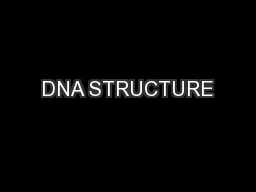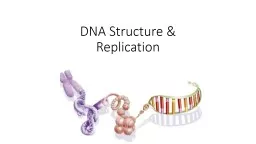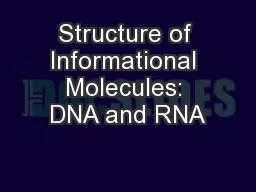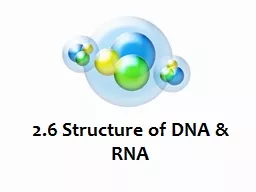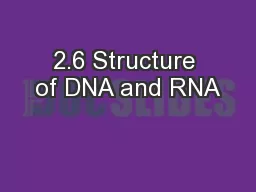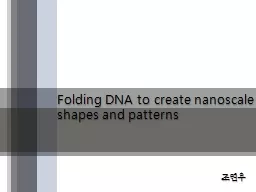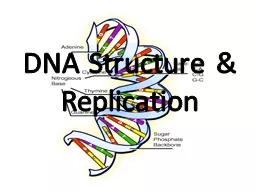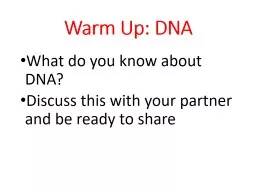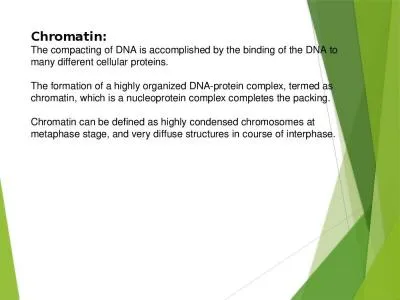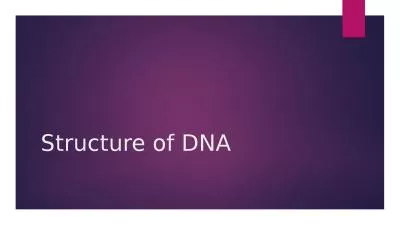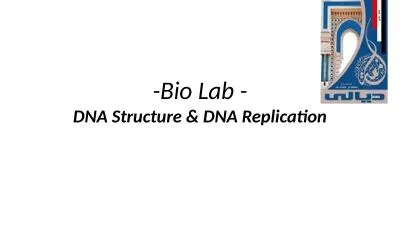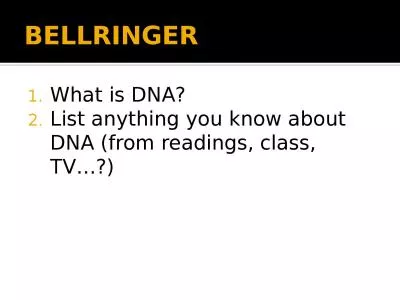PPT-DNA STRUCTURE
Author : danika-pritchard | Published Date : 2016-04-30
DNA is composed of polynucleotide chains The helical structure of DNA Formation of Nucleotides Structure of polynucleotide polymer Each base has its preferred
Presentation Embed Code
Download Presentation
Download Presentation The PPT/PDF document "DNA STRUCTURE" is the property of its rightful owner. Permission is granted to download and print the materials on this website for personal, non-commercial use only, and to display it on your personal computer provided you do not modify the materials and that you retain all copyright notices contained in the materials. By downloading content from our website, you accept the terms of this agreement.
DNA STRUCTURE: Transcript
DNA is composed of polynucleotide chains The helical structure of DNA Formation of Nucleotides Structure of polynucleotide polymer Each base has its preferred tautomeric form Purine and . 3.3.1: Outline DNA nucleotide structure in terms of sugar (deoxyribose), base. and phosphate.. 3.3.2: State the names of the four bases in DNA.. 3.3.3: Outline how DNA nucleotides are linked together by covalent bonds. DNA Structure. The discovery of the structure. Francis Crick and James Watson. The deoxyribonucleic acid (DNA) molecule is the genetic blueprint for each cell and ultimately the blueprint that determines every characteristic of a living organism. The DNA molecule was discovered in 1951 by Francis Crick, James Watson, and Maurice Wilkins using X-ray diffraction. . Stryer. Short course. Chapter 33. Nucleic Acid Structure. Nucleobase. Nucleoside. Nucleotide. Nucleic acid. Chromatin. Chromosome. Polymeric Structure. Polymer ideal for informational molecule. Ribose and deoxyribose. Nucleic Acids. What do we know already?. i. . The nucleic acids DNA and RNA are polymers of nucleotides. Nucleotides consist of 3 parts. A 5-carbon sugar – ribose or deoxyribose. A phosphate group (acidic & negatively-charged). Essential idea: The structure of DNA allows efficient storage of genetic information.. There is 2m of DNA in each human cell, however the most cells in the human body have a diameter of 10 . μm. . This DNA is divided in chromosomes and coiled around proteins called histones so that it can be efficiently stored in each cell's nucleus. The human genome project which has decoded the case sequence for the whole 2m of the human genome requires a data warehouse (pictured) to store the information electronically. This should give a good idea of just how efficient DNA is at storing information and why it needs to be so.. shapes and patterns. 조연우. Contents. DNA. DNA origami. The application of DNA origami. DNA origami structure. “Normal DNA”. 이중나선 형태로 존재. Double Stranded, Double Helix. Adenine, Thymine, Guanine, Cytosine . Objectives. To explain how instructions in DNA lead to different cells and result in cells being able to perform certain tasks in an organism. Identify the building blocks and nitrogenous bases (A, T, G, C and U) of nucleic acids . DNA damage DNA gets damaged a lot ! DNA damage DNA gets damaged a lot! >200,000 events/human cell/day DNA damage Occurs 2 ways 1) spontaneously 2) mutagens : damage DNA Transposons Discovered by Barbara McClintock DNA GLOW Lab A new way to investigate DNA structure. V1.1: June 2018 © Copyright by Amplyus LLC, all rights reserved We bring the study of DNA structure to your hands Patent pending DNA GLOW Lab Discuss this with your partner and be ready to share. DNA. . Oswald Avery . (1944). Discovered that the nucleic acid. , . DNA,. stores . and . transmits . the genetic information from one . generation . The formation of a highly organized DNA-protein complex, termed as chromatin, which is a nucleoprotein complex completes the packing.. Chromatin can be defined as highly condensed chromosomes at metaphase stage, and very diffuse structures in course of . Mini whiteboards. Sweets for DNA model (see link to sheet on slide). Speakers. Practical ‘DNA your onions’: blender, knife, white tile, water bath (60. o. C), ice, thermometer, beakers, funnel, filter paper, syringe, boiling tube, glass rod, pipette, protease, washing up liquid, salt, 95% ice cold ethanol. . What is DNA?. DNA is a . Nucleic Acid in the nucleus. Polymer of . Nucleotides. Each nucleotide consists of. Deoxy. ribose (5-carbon sugar) . Phosphate group. a nitrogen-containing base. Four bases. DNA Structure Simulation. Before we begin, let’s investigate the way DNA molecules are set up!. http://learn.genetics.utah.edu/content/molecules/builddna/. The Structure of DNA. What is DNA?. A bit about DNA….
Download Document
Here is the link to download the presentation.
"DNA STRUCTURE"The content belongs to its owner. You may download and print it for personal use, without modification, and keep all copyright notices. By downloading, you agree to these terms.
Related Documents

